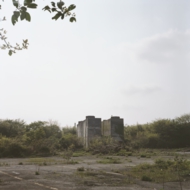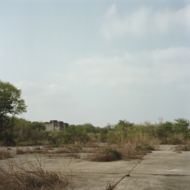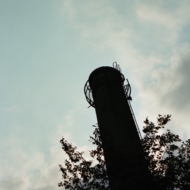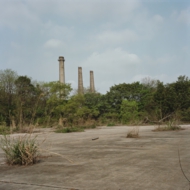
memory - Tachikawa air base
2008, type C print
Minako Saitoh - The Degree of Distantness
Lee Mi Na
(Chief curator at the Museum of Modern Art, Kamakura & Hayama)
translated by Satoru Nagoya
Since I visited Saitoh’s solo exhibition “Memory – Kaminohashi Bridge” in October last year, I have been obsessed with the matter of distantness.
On large square panels, of which one side measured more than 100 cm, landscape photographs were printed, with white margins left around. Seen there were a river, a bridge, a field, weeds, electric wires, and clouds – views without any peculiarities. There were no eye-catching buildings or vivid colors, and not a single soul was to be found. The photographs were so vague that the viewer would be at a loss what to see in them. However, all photographs showed the wide sky. And they made me sense light. There were no definite objects of photographing, and the photographed trees, clouds, sky, sunlight and the empty space left around them loosely mingled together, to present the sign of an atmosphere.
Including those in photographs one size smaller, the large and small landscapes were shown in sequence, with an interval of about one step and a half, if I walked slowly, between them. The photographs were spotlighted, but it seemed as though the square photographs were emitting light themselves. In the inner part of the gallery, there were an old desk and a round chair – I wondered if it was a sewing machine of bygone days. On the desk, an old piece of cloth was spread, like the work had been halfway done. Put on the cloth was a reddish brown photograph of a young woman. On the walls and on the floor as well, lighting was provided only where something was exhibited, and the rest of the space was dim and quiet. The boundaries between the photographs on the walls and the space around them became loose, and the air that the landscapes were embracing flowed out.
The landscapes in front of the artist, in which the known and the unknown were mixed, remained as they were, but a sort of wavering was felt, as if I were in a different sphere. A steadfast sense of reality felt at the bottom of things contradicting each other. Not only the photographs but also the modest objects altogether evoke these feelings, and this may be what Saitoh’s work is.
What brought forth the exhibition “Kaminohashi Bridge” was the sudden death of her mother. After taking a slow round in the gallery, I heard from the artist that the landscapes photographed were those which her late mother might have seen and the cloth on the desk was from happy early days of the mother who had learned dressmaking. But I did not feel any cheap sympathy with the photographs and the space. What I felt was something in a different direction: a sense of getting distant, as if everything around me were being distanced from me, and as if even I were distancing myself from me.
Earlier works of Saitoh each showed a bit of expression of her thoughts on such issues as the socially weak and the interpretation of history, and the work and the artist existed almost as one and indivisible. I think, for the artist, photography at that time was just one tool among others. In the beginning of the “Memory” series several years ago, when she was photographing windows of a mental hospital, she began to use the camera, which is basically a tool to record what one witnesses, as part of a bodily process to dislocate herself from the act of witnessing, and thus the meaning of her works being photographs became weightier, I guess. It seems that this transformation of relationship is rapidly under way, through her exhibits at the Echigo-Tsumari Art Triennial in 2006 and the solo show last year.
Saitoh’s photographs possess, at their bottom, a structure for her to experience what others have experienced. Especially, the “Memory” series has a strong tendency toward that. When she photographed the outside through the mental hospital windows, she was tracing the acts of some patients who might have seen the outside views from the windows. For a photograph of a dead tree in a snow field, she listened, for several nights, to the story of the life of a woman who married into a family in the Tsumari district, a heavy snowfall area, and walked the snowy paths which the woman once walked. For “Paper Bridge” she looked for her mother’s old house, visited the mother’s old friends, to collect the life of her mother before giving birth to the artist. Each time, Saitoh herself goes down to a considerably deep place and accompanies the feelings and circumstances of the people she takes up. Sometimes she faces them to the extent that she thinks she might break down if she went further. And she visits some scenes, tracing the eyes of the people she faces.
But Saitoh doesn’t photograph the records of witnessing things. She starts from the eyes of the person she took up, once lays her own eyes on the person’s, makes a spiral turn around from that point, and seeks the moment at which a view turns a different one, taking enough time. By taking photographs, she distances from herself what she has once got, as if to rip it off herself. Experiencing others’ experiences has sunk to the bottom of the working process, and now, as the photographed things look vague despite the overall strong touch, it seems as if the artist is making an effort to distance even those which her eyes have seen, from the photographs with their images. The distantness gradually progressed, and in “Paper Bridge” it reached the point where – although the starting point was her own mother, which was the nearest ever to her – the degree of distantness of the photograph was felt to be the highest. And the installation barely moored the photographs getting distant to the starting point, to broaden the range of distantness of all the works.
Sometimes, the farther we look back to the past, the farther the future is felt. The degree of distantness might not only mean getting distant. I seem to be going to visit this exhibition too, to see the degree.



